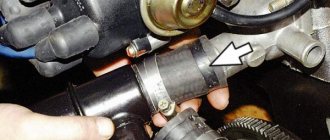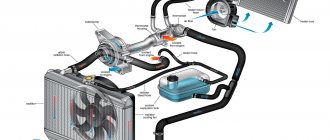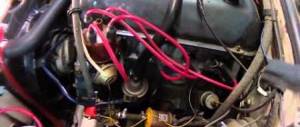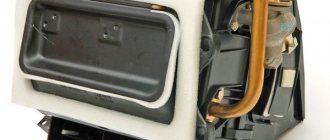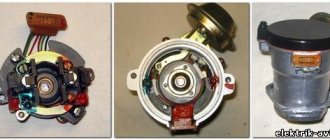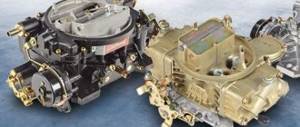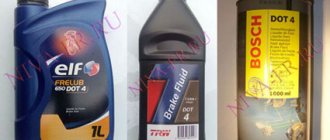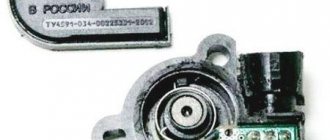Cooling system VAZ 2109 injector
The cooling system of the internal combustion engine appeared almost simultaneously with it and has not undergone any significant changes since then. This primarily applies to long-lived domestic cars that will outlive you and me. Therefore, we need to know their design by heart if we do not plan to change to something more modern. The VAZ 2109, like the eight, is also considered one of the domestic eternal cars, for which there is no alternative. Today we will dive into the uncontested, ancient, like the trachea of the first amphibians, cooling system of the first front-wheel drive vehicles. Nines, and identical engines with an injector.
Parameters of the VAZ 2109 injector cooling system
The cooling system of the VAZ 2109 injector is practically no different from other VAZ cooling systems. The proud prefix “injector” may indicate that the system has a thermostat of a different configuration, but this is not a fact. It can also be a regular number eight. We won’t start spewing letters about how a cooling system is necessary and you can’t go anywhere without it; even a child can understand this. We present only some book parameters for precise control of system performance. Parameters are temperature conditions that the system must maintain and adjust, depending on the condition of the engine.
- The volume of the cooling system of the nine is 7.8 liters. They pour whatever they like into the system, but we would not recommend following the lead of genetic memory and pouring Antifreeze into the expansion tank. Real Antifreeze A40 has not been produced for twenty years, and what is sold under this brand is rare rubbish, not recommended for use. Nine will gladly swallow any coolant recommended by AvtoVAZ or similar in composition.
- 99 degrees is the closing temperature of the fan motor relay. 93 degrees is the contact opening temperature, then the fan turns off. Knowing this, you can find out the approximate coolant temperature without a suspicious thermometer on the panel. The normal operating temperature of antifreeze is 85-95 degrees.
- The thermostat of the cooling system divides it into two circuits - large and small. This is convenient in the cold season, when, in order to quickly warm up the engine, the thermostat valve closes a large circle and the antifreeze circulates in a small circle. When it warms up to operating temperature or so, the valve opens and the antifreeze enters the large complete cooling circuit.
- The nine pump is of a centrifugal type and is driven by a timing belt. It must create a pressure in the cooling system of about 1 atmosphere. The impeller is made of metal-ceramic, the pump shaft rotates on plain bearings, which must be lubricated from the factory with Litol 24 grease. It is not maintained during operation, and in case of failure, in theory, cannot be restored.
Flushing the VAZ 2109 engine cooling system
From time to time, the eight and nine engine requires flushing the cooling system. This is mainly due to the use of low-quality coolants such as antifreeze, which contributes to the formation of plaque and deposits on the walls of the water jacket. Such liquids have an even more destructive effect on the heater radiator and on the main radiator of the cooling system. If the radiator is tightly clogged with coolant decomposition products, it is simply unable to perform its function and the engine instantly overheats even in cold weather. And this doesn’t mean anything good. This is why the cooling system should be flushed.
How to flush the cooling system of a VAZ 2109
You can rinse the cooling system with ordinary boiled (!) water. Boiled, because this way we minimize the amount of salts and minerals in the water that will remain after flushing in the system. Flushing the system is easy. The old fluid is drained, boiled water is poured in, the engine is allowed to idle for 15-20 minutes, after which the water is drained.
This method is ineffective, but very cheap, because water is practically free. If the owner does not spare 300-500 rubles for a special means for flushing the system, then the effect of the procedure will be a hundred times higher. The fact is that these flushes contain substances that carefully and carefully remove scale and coolant decomposition products. And this is a truly effective flush. For example, liquid for flushing the BBF system costs about 300 rubles per flush. After washing, even plaque is removed; the main thing is to strictly follow the instructions.
Air lock in the cooling system
Sometimes, during the operation of poor quality liquids, air pockets form in the cooling system. The plug prevents coolant circulation through the system, so air must be removed in a timely manner. The plug is removed in the same way as removing plugs in the brake system, since the cooling system of the VAZ 2109 also operates under tight conditions.
The easiest way to remove a plug is shown in the picture. Its essence is that with the help of any pump or automobile manual compressor we create excess pressure in the system, the liquid is driven through all the hard-to-reach nooks and crannies of the cooling system and exits through the upper radiator pipe, the hose from which is lowered into a container with coolant. We constantly add new fluid to the tank, after which we build up pressure in the system. Thus, no matter what the plug is, it will definitely be pressed through and the air will escape through the top can of the radiator.
These simple methods are used to service the simple cooling system of the VAZ 2109, even with an injector, a carburetor, or two. Control the temperature, do not boil unnecessarily and cool in time. Happy and safe travels to everyone!
Thermostat
This element of the system also plays almost the main role. Although in fact, of course, the system can work without it. The cooling system of the VAZ 2109 engine is designed in such a way that the engine first warms up to operating temperature - about 90 degrees. After this, it is necessary to further cool the liquid. But the fact is that at first the antifreeze moves in a small circle - it passes through the cooling jacket, enters the heater radiator, and the excess goes into the expansion tank.
But when it warms up to operating temperature, the thermostat directs a flow of liquid into the radiator. How it works will be discussed a little below. A thermostat is a kind of mechanical valve. But it has a small modification that allows you to automate the cooling operation. A simple bimetallic strip that deforms when exposed to hot liquid. With its help, the antifreeze supply valve to the radiator opens/closes.
How many liters of cooling system for VAZ 2109
How much antifreeze should I pour into the VAZ-2109 and what kind of antifreeze is better to pour? A short educational program for those who want to meet the winter fully armed and not freeze the engine block.
To replace antifreeze you need 10 liters, about 8 liters fit into the car, but it will be useful for topping up. It is also better to immediately buy a funnel, distilled water and rinsing agent. Especially if the car has been driven on water before.
Changing the coolant on a VAZ-2109 is a real hemorrhoid. If on other cars it is enough to unscrew the tap on the radiator and drain everything, then here you need to bother. Many people unscrew the lower hose of the heater, blow into the expansion tank, squeezing out the drops, but here it all depends on the love for the car. The principle is very simple - first remove old fluid from all lower points of the pipes, and then remove air plugs from all upper points.
First you should drain the old water or antifreeze. To do this you need:
- Turn the heater tap to the red position;
- Remove the plug from the expansion tank;
- Unscrew the tap on the radiator;
- Unscrew the drain bolt on the engine.
Drain the old fluid, you can flush the system with water or a special product. Next, we begin to fill. The capacity of the cooling system of the VAZ-2109 is 8.7 liters, about 7 liters are first filled in. There is no need to rush - the system should be filled to the maximum, then you can start the engine, warm it up so that the thermostat opens, and then add the remaining antifreeze. You need to pour it in a continuous and even stream, without unnecessary bubbling, so that air does not get in with the antifreeze - it is unrealistically difficult to expel it from the system. But, as a rule, a certain amount of air still accumulates, forming a plug.
What antifreeze should I use?
For cars up to 90, you need blue antifreeze. From 90 to 99 – green. After 2000 – red. You can buy the cheapest options; the machine can easily digest them. The main thing is that it doesn’t freeze (in Russia they sometimes sell fakes that freeze).
To get rid of the plug, you can drive the car up a hill, open the expansion tank cap, and give all the gas a good boost to get all the bubbles out. To make the antifreeze drain better, you can remove the top tube of the pipe - the process will go faster due to the air. Before filling, hold this tube until antifreeze begins to ooze from it, after which we attach it in place and top up completely. If coolant gets on the engine, it must be wiped with a rag.
As a rule, how much antifreeze will fit into the VAZ-2109 can be seen in the expansion tank - the liquid should be between the MIN and MAX marks.
How to remove an air lock from the engine cooling system on VAZ 2108, 2109, 21099 cars
After replacing the coolant on VAZ 2108, 2109, 21099 cars, an air lock or even several air locks almost always appear in the engine cooling system.
If, after replacing the coolant, the heater begins to heat poorly or the engine begins to constantly overheat, it makes sense to remove the air lock from the system.
Ways to eliminate air lock
When carrying out work, you need to know that air usually accumulates at the highest points of the system. On VAZ 2108, 2109, 21099 cars this is a heating unit for the carburetor throttle valve area (two hoses go to it) or a throttle pipe on an injection engine (two hoses also go to it). The place where an air lock appears can also be the heater radiator - “stove”.
Method one
Warm up the engine to operating temperature. We jam it. Let it sit for five minutes. Remove the long hose from the carburetor heating unit or throttle pipe. We start the engine or simply crank it with the starter. As soon as coolant flows from the hose, put it back on the fitting. Care should be taken when carrying out work, as the coolant is hot.
Method two
More radical. Suitable for airing the stove.
We drive the car with its front wheels onto a slope so that the nose is lifted up and slightly higher than the stern (see photo at the beginning of the article). We start the engine and warm it up to operating temperature. We jam it. Remove one of the hoses to the carburetor heating block or throttle pipe. We start the engine or crank it with the starter. When coolant appears from the hose, put it on the fitting.
In particularly advanced cases, you can repeat the operation to remove the air plug several times. It is most convenient to carry out the work with an assistant, but if he is not present, you should place a container under the removed hose to collect the liquid.
Notes and additions
If you follow a few simple rules when replacing coolant, you can avoid problems with air locks.
— Fill the liquid slowly, in small portions.
— During filling, compress the pipes to the radiator and thermostat, pumping liquid.
— Before adding coolant, remove one of the hoses on the carburetor heating block or on the throttle pipe on an injection engine. This is where the air will be forced out.
Cooling system VAZ 2109 small and large circle
Why an engine cooling system is needed can already be guessed from the name - when working, the engine heats up and cools through the radiator. That's it in a nutshell. In fact, the task of the engine cooling system is to maintain its temperature in a certain range (85-100 degrees), called operating temperature. At operating temperature, the motor operates as efficiently and safely as possible.
Large and small circle of the engine cooling system
After starting, the engine must reach operating temperature as quickly as possible. For this purpose, the cooling system is divided into two parts - a small circle and a large circulation circle. In a small circle, the coolant circulates as close as possible to the cylinders and, accordingly, heats up as quickly as possible. As soon as it warms up to the highest operating temperature, the valve opens and the liquid flows into a large circle, where it prevents the engine from overheating. The task of the small circle is to maintain the operating temperature, and the large circle is to remove excess heat.
Heater as part of the engine cooling system
It’s nice when the interior warms up quickly, but this happens because the stove is part of a small circulation circle. Through the hoses, the liquid goes to the heater radiator and returns back. What does it mean? In order for the heater to start blowing warm air faster, it must be turned on when the engine warms up.
Thermostat and pump
Cooling system pump and thermostat
So, we found out that the engine does not overheat due to coolant circulation. But what makes the liquid move? The answer is a pump. This is a special pump that is driven by an engine through a belt, but there are also pumps with an electric motor. The main pump malfunctions are associated with leakage through the drainage hole and bearing wear (accompanied by a squeaking sound). There are also pumps with a plastic impeller, which is corroded by low-quality antifreeze.
The thermostat is the same valve that opens when the coolant heats up and circulates it in a large circle. Consists of a cylinder containing a substance that expands when heated; Having reached a certain temperature, it squeezes out the stem and opens the valve. Once cooled, the rod retracts and the valve closes.
Radiator and expansion tank of the engine cooling system
The radiator is part of a large circle and is installed in front of the car. Liquid circulates in it, which is cooled by counter air and a fan.
The fan operates on suction so as not to interfere with the oncoming air flow.
The radiator cap maintains pressure in the cooling system. It has a valve that opens when the pressure exceeds the operating pressure and releases excess liquid through a hose into the expansion tank.
The expansion tank is needed to store the liquid needed for cooling. When the antifreeze in the expansion tank cools, it will return through the hose back to the radiator, excluding air from entering. There are combined tanks with a valve cover.
This is how the engine cooling system works . Among the main problems associated with this system it is worth highlighting:
- leak - can appear anywhere, from the block channels to the expansion tank;
The main reason is excess pressure due to a faulty radiator cap/ext. tank
- overheating occurs unexpectedly, but there is no need to panic. It is better to turn on the heater at full speed, turn on the highest speed, stop coasting and turn off the engine.
Do not perform any actions until the system has cooled down.
The main reasons are that all the coolant in the system has leaked, the fan has failed, the radiator is clogged, the thermostat or pump has failed.
- The stove does not work well - it blows cold air;
The main reasons are the lack of antifreeze , the thermostat broke in the open position.
The cooling system of the VAZ 2109 is airy, what should I do?
Sensitive subject. This happened last year. I can’t find the reason, air is constantly appearing from somewhere in the cooling system, all the clamps and pipes are tightened, everything is fine, the radiators are not leaking, the pump is new, the thermostat is original 08, working, opens to 90, the cylinder head gasket is intact, the conservator cap is new, there is no antifreeze anywhere doesn't flow. This air is already full of antifreeze, I’ve already pumped out a liter and a half because it’s about to leak through the lid. hence the stove blows cold air. and so on every day. I think it’s leaking through the steam outlet, but not sure, even today, when I poured antifreeze from the tank into the canister, air bubbles appeared in it, but then they all burst, should I change the antifreeze? not exactly either.
I found the reason, thanks to everyone who responded) this is a fiasco, handy. I spent 2 evenings scouring the Internet, looking for information and reasons. 1 person here on the drive wrote about the possible causes of airing, if there are no problems with the pipes, pump and cylinder head gasket, then I just put this complex puzzle together and figured out what’s going on) please don’t throw stones and slippers)))
I advise anyone who is thinking of installing a fuel filter on the return line, or has already installed it, to remove it, at least for the winter) Because of this, the cooling system is aired out, and coolant circulation is disrupted + hence all the consequences, the heater does not heat up at idle, the engine boils due to air in the system , + increased wear and consumption.

